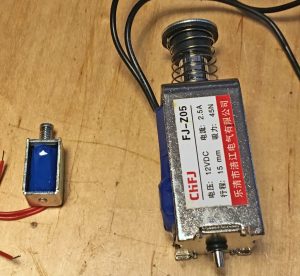While struggling to make progress in the PipeMare project, we also work on expanding our selection of basic percussion instruments. We are currently experimenting with some kind of bass drum effect – without an actual bass drum. The plan is to use a cheap bodhrán and one or two modified bass drum pedals.
Instead of a foot stomping on the pedal, we are going to use some kind of heavy-duty actuator. Our first idea was to use the kind of bi-directional linear actuators used in car locks. These are very easy to control electrically and apply mechanically, and they are very strong. But they do have a serious flaw: Overheating. A bass drum is expected to be able to beat several times per second over a longer period of time, and that is a bit too much for the internal motor and gearing of a car lock actuator.
So, instead we turn to our usual fall-back plan: solenoids! The linear solenoids we’ve used so far, are not strong enough to pull a bass drum pedal, so we have to take it to the next level.

Here is our primary candidate, compared to one of the solenoids used in our glockenspiel. It’s a 12 V solenoid, with a stroke force of 45 Newton (or appx. 4.5 kg) and a 15 mm stroke length. It looks and feels like it could easily tear apart the entire EnsembleBot. It should be strong enough to pull the bass drum pedal with sufficient force, and it won’t overheat. Our greatest concern is how the power supply is going to react to the sudden sinking of 2.5 A on the 12 V line. Some huge capacitors across the MOSFET driver might be a good idea.
Speaking of MOSFETs, most of our older homemade driver modules used more generic MOSFETs like IRF520 or IRF530. While they open up sufficiently for the smaller solenoids, they’ve driven so far, we’d like to be sure, that they are fully open (i.e. lowest resistance) to drive these large solenoids. So, we’ll have to either replace them with logic-level MOSFETs (e.g. IRL540) or (perhaps easier) just build a new MOSFET array module.
We are also going to finish our dual woodblock, to be mounted inside the main cabinet with the tubular bells and the snare drum. The components and the mechanics will be very similar to the snare drum, so there’s really no excuse for the delay.